Reclaiming Ancient traces˙ the Ancient Circuit Wall of Athens by Ioannis Giannakopoulos-Tselikas aims to retrieve and showcase a large amount of unveiling wall remnants of the “Ancient Circuit Wall of Athens”, also known as the “Themistoclean Fortification”, which remain concealed beneath modern city growth and its urban terrain.
-text by the author
Wandering around the Athenian city-center, it is difficult to perceive and distinguish the “borderline” between ancient and modern. Intertwining both the apparent and concealed historical landscape with the institutional and built urban landscape, there has been an obscured relevance between them. A key element of differentiation and delimitation missing in the modern reality of Athens and seeking its Retrieval is the “Ancient Circuit Wall of Athens”, also known as the “Themistoclean Fortification”, dated between the mid-4th century and the 2nd century B.C.
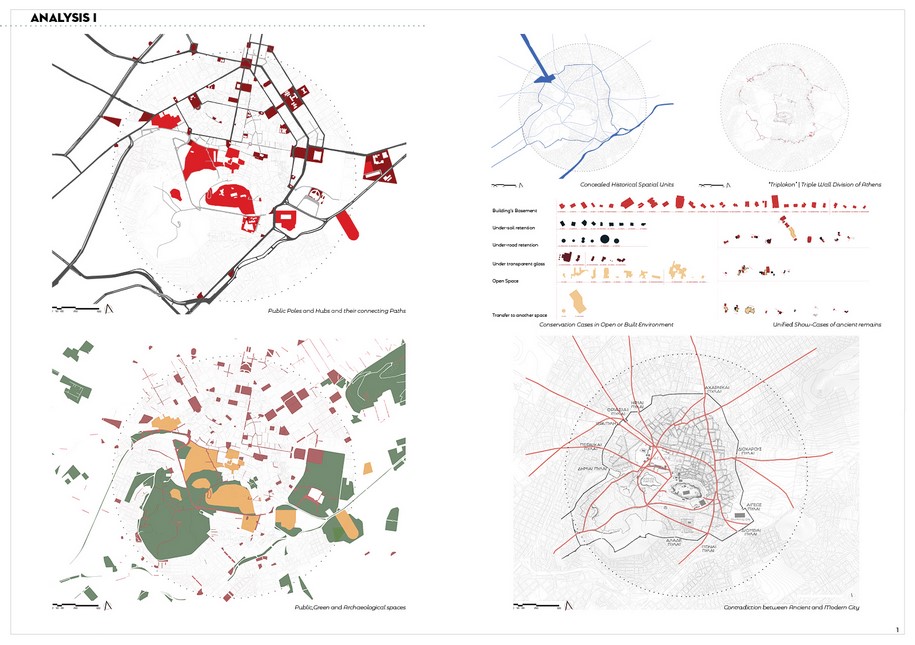
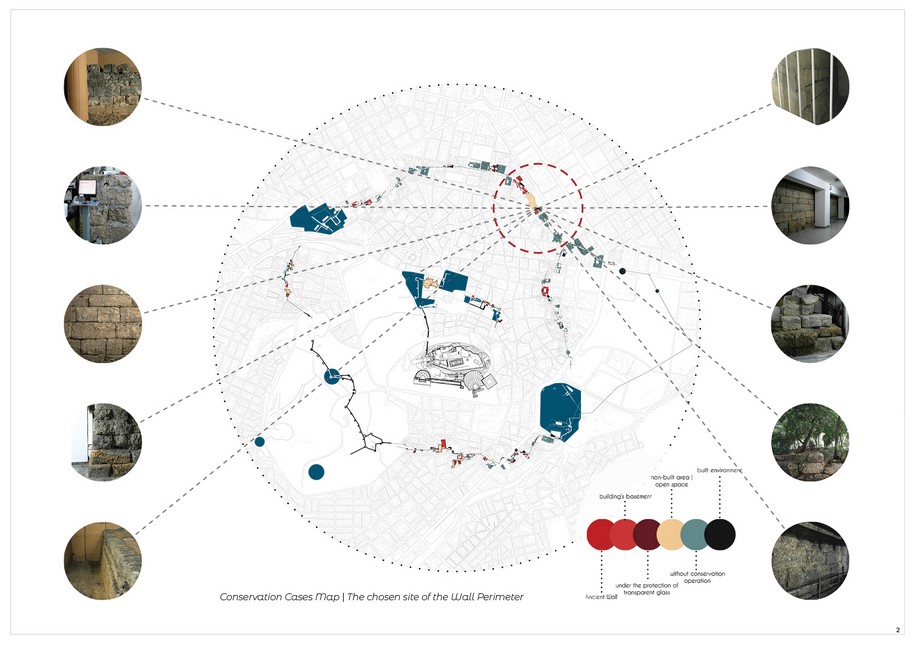
The aim of the study is to retrieve and showcase a large amount of unveiling wall remnants, which remain concealed beneath modern city growth and its urban terrain, at a low or large depth, between infrastructures and building foundations. As a result, this will reify the upcoming enhance of both the historical monument, and the urban landscape, which is expected to play the critical role of ancient wall’s “urban vitrine”.
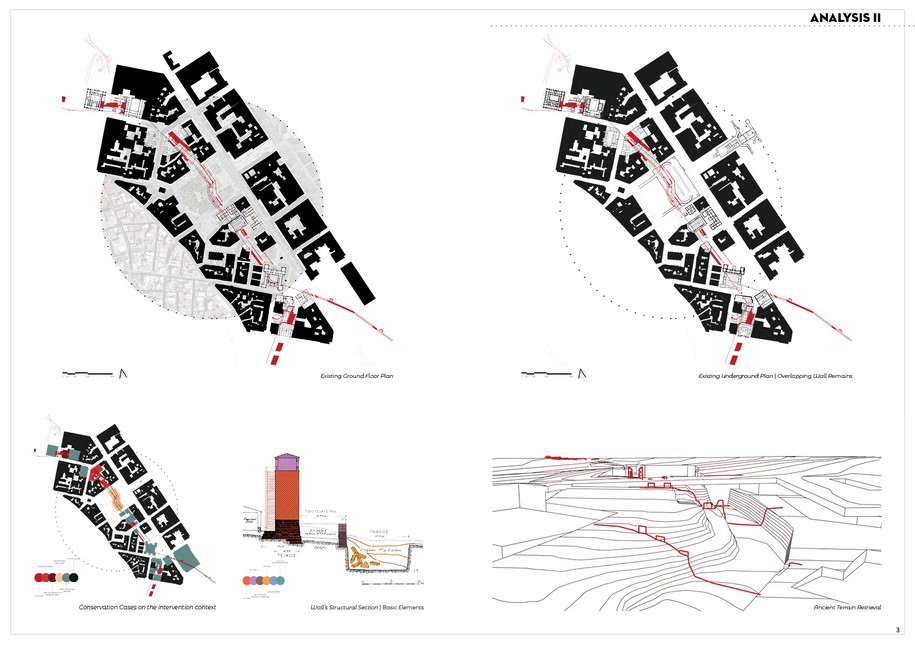
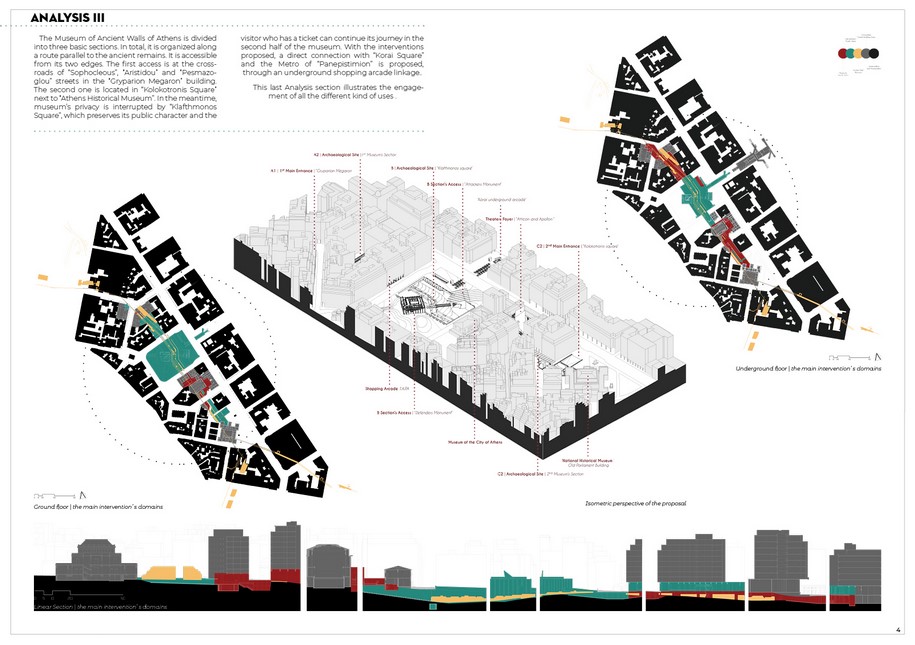
The promotion strategy of reclaiming the “ancient circuit wall” is used, serves the unified promotion of a large part of the fortification, where the archaeological remains and information derived from wall’s positions, form and placement, create a breeding ground for its capture. Moreover, this chosen part of the wall is located in the Athenian city-center and specifically northeast oriented within the “historical triangle”. As a result, it overlaps with interesting public and private buildings, and open spaces.
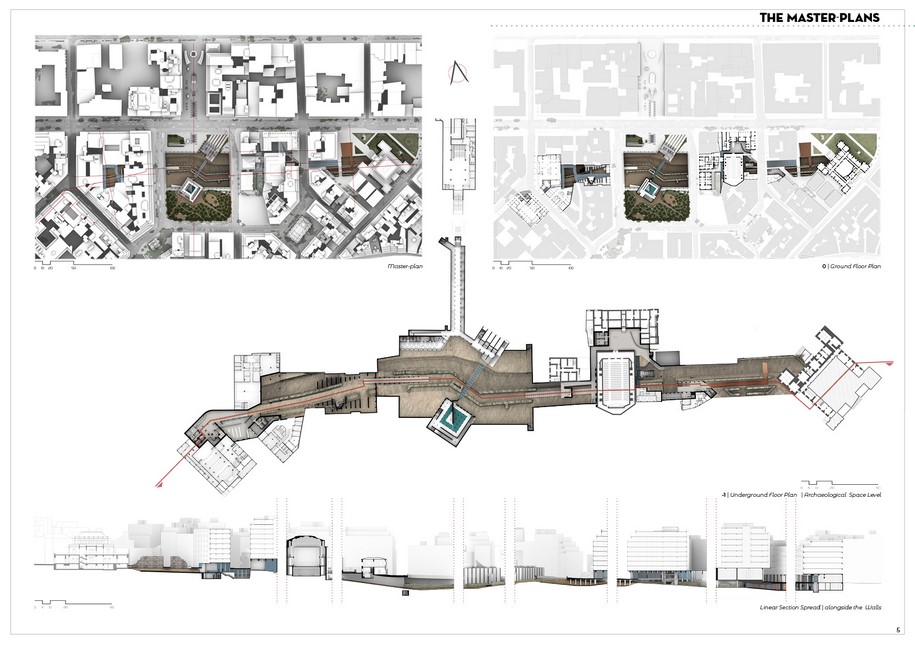
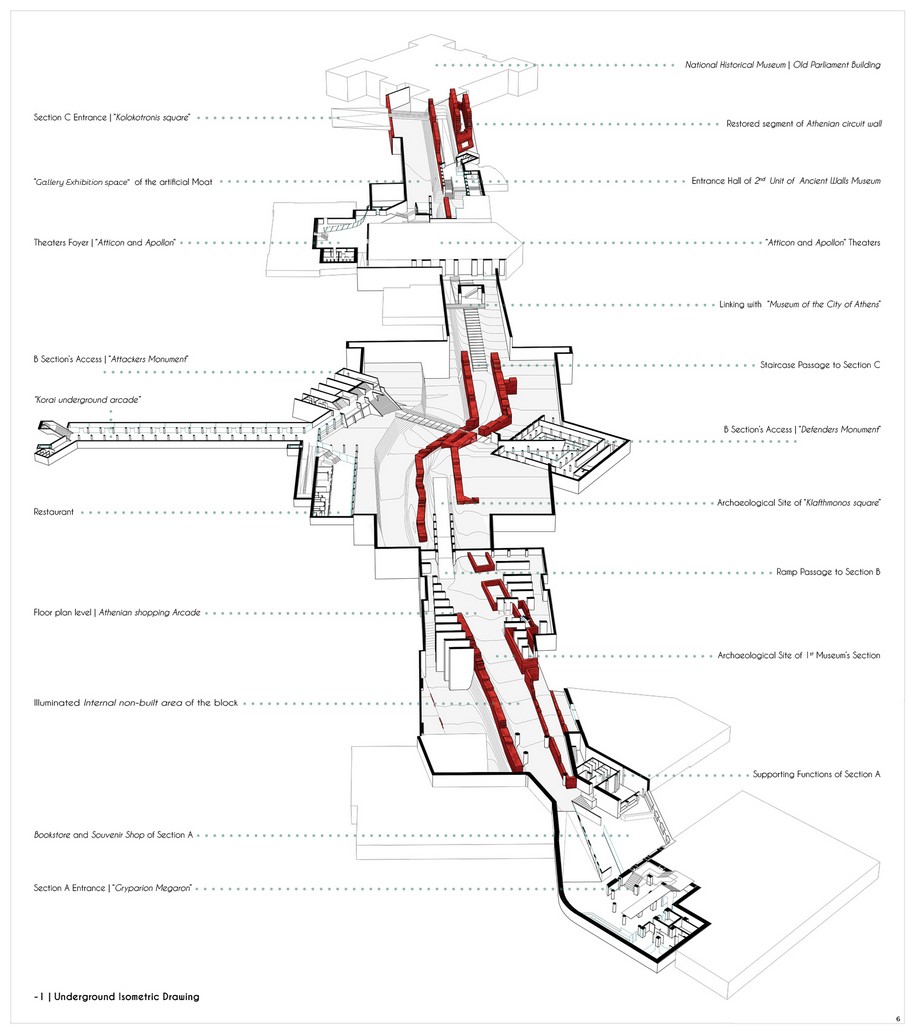
This kind of unified showcase of the Athenian wall-monument, is an urban intervention, which includes both the archaeological walk on the ancient level of the bedrock (ancient rocky terrain), and the urban walk in the structured and non-structured environment of modern city in which the historical landmark is revealed and is highlighted.
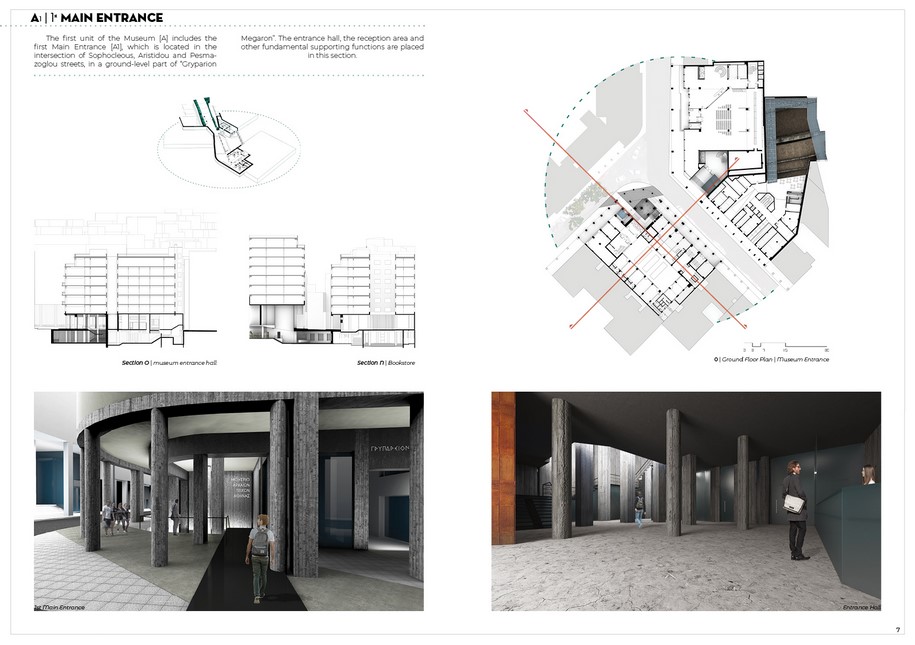
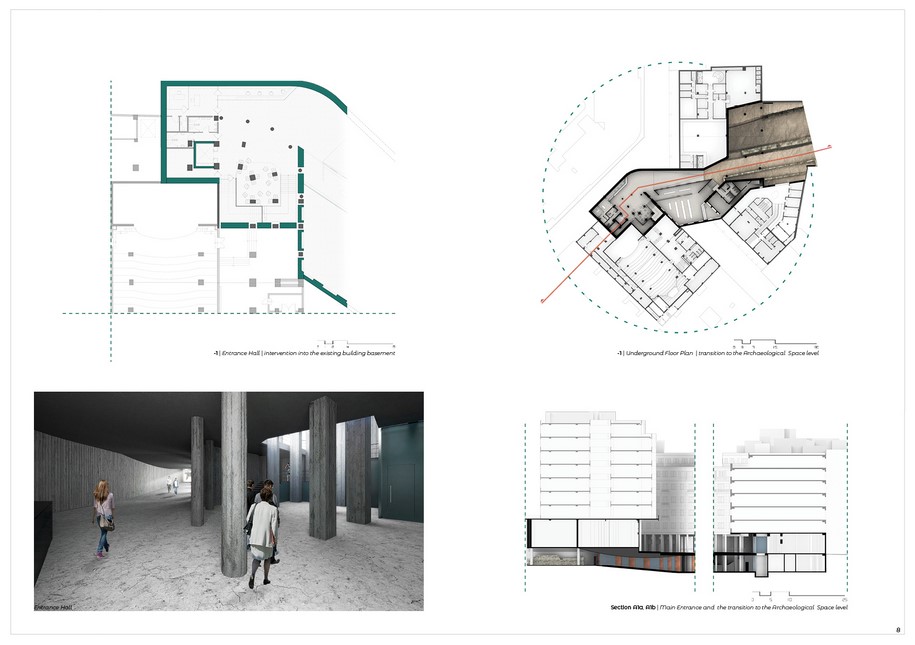
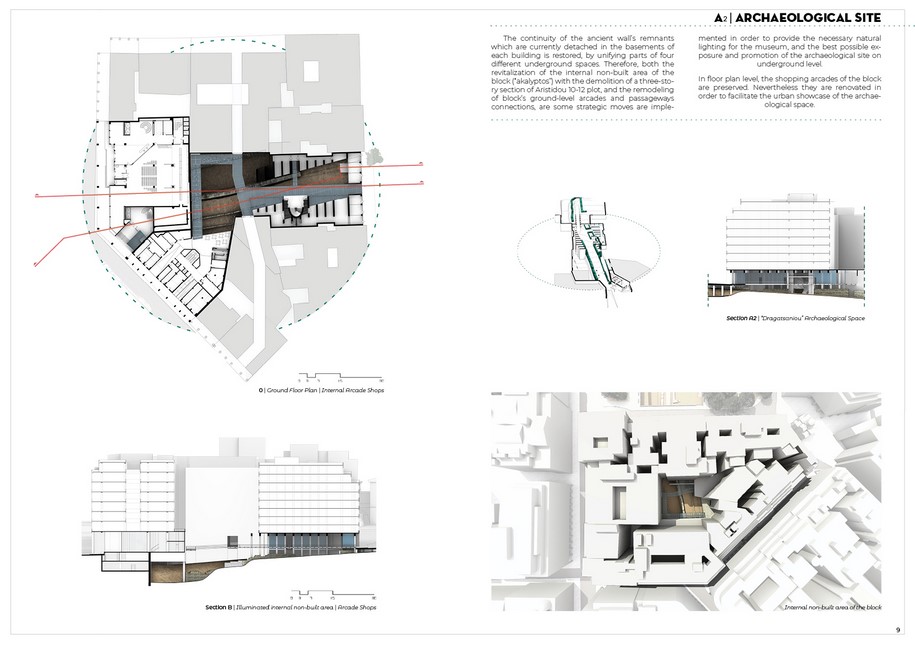
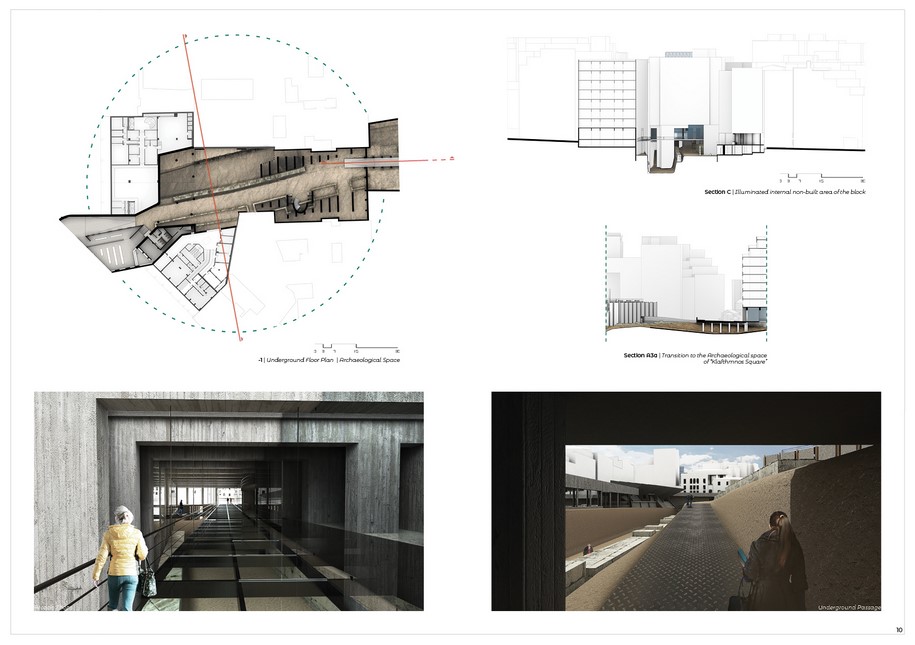
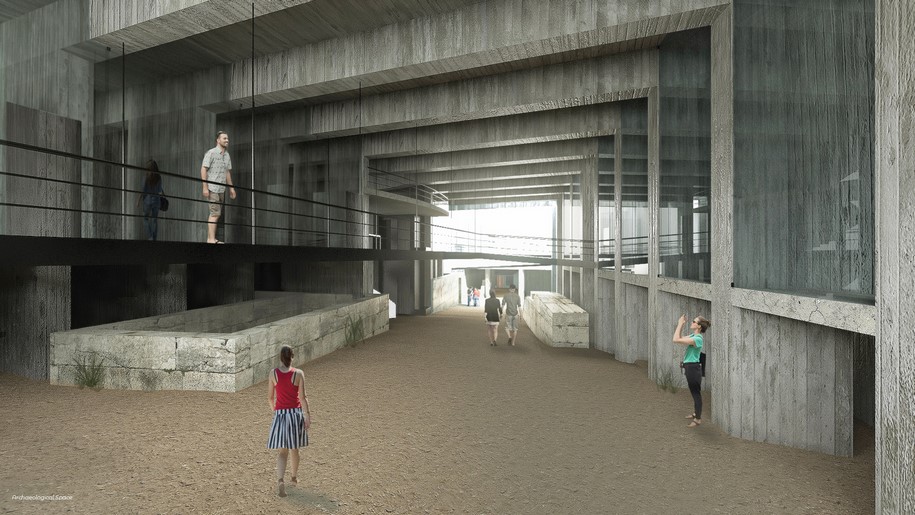
Focusing on the intervention, it starts and ends from the “Gryparion Megaron” to “Kolokotronis Square” or vice versa. In-between, intervention includes “Klafthmonos square” and the two building blocks on either side of it. The entire venture is supported by the creation of the “Museum of the Athenian ancient circuit wall” interrupted by “Klafthmonos square” where both its archaeological site and its interventions presented, preserve its public character.
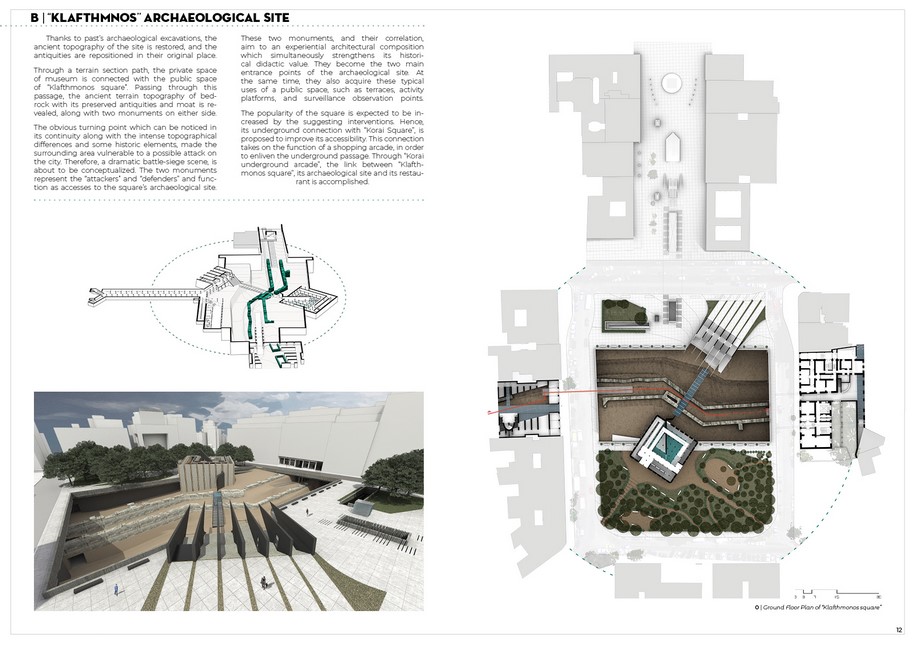
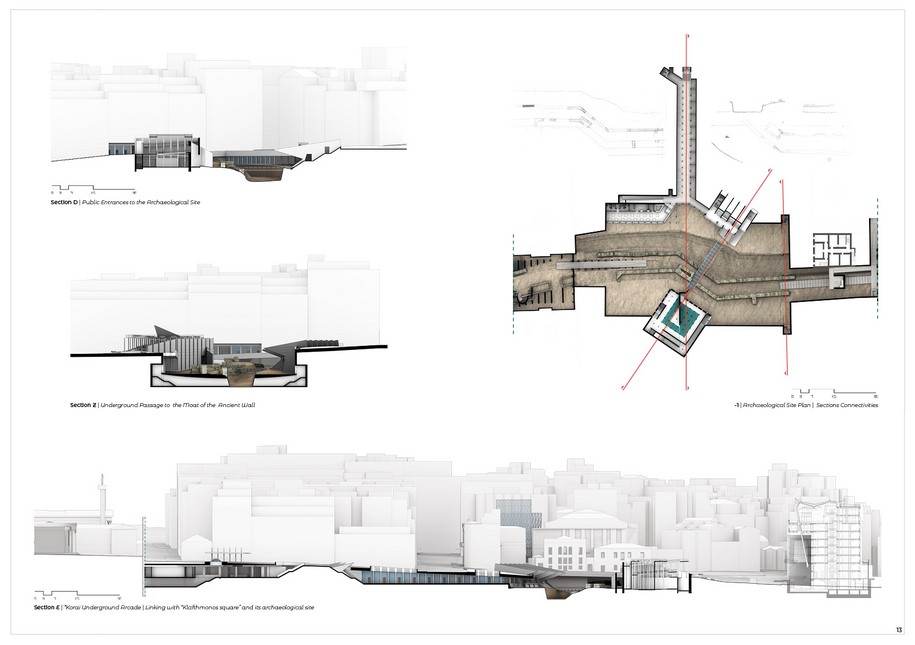
The proposal is divided into three basic units. In total, it is organized along a route parallel to the ancient remains, on the space between the main “Curtain” and the “Proteichisma”, which was used as ancient “external ring road”.
Showcasing the ancient Circuit Wall of Athens, along with its archaeological physical remains, is able to have a major contribution to realize the authentic city’s historical core. As a result, the essential relationship between the Athenian citizen and the history of his city is strengthened.
Last but not least, in this project, modern urban Athenian elements that are either neglected and degraded or inactive and destroyed, both reinforce the emergence of this archaeological landmark and be reinforced by it. Such elements are internal non-built areas of building blocks (“akalyptos” in Greek), shopping arcades, cultural spaces such as museums and theaters, open public spaces such as squares and residual spaces of built environment. This unified linear urban intervention integrates all of these different aspects of the city, supports and reclaim them.
The Athenian city is upgraded.
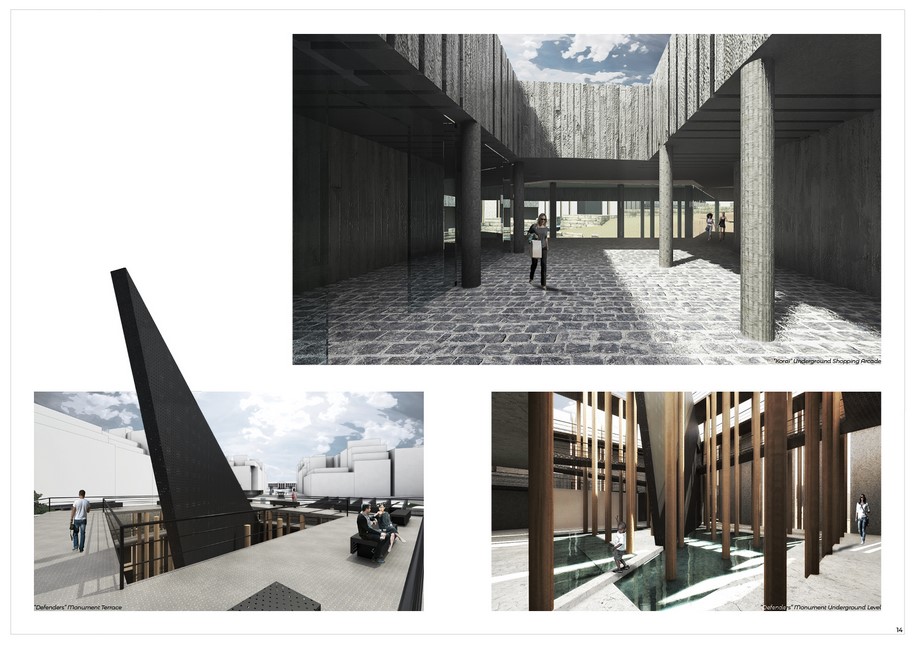
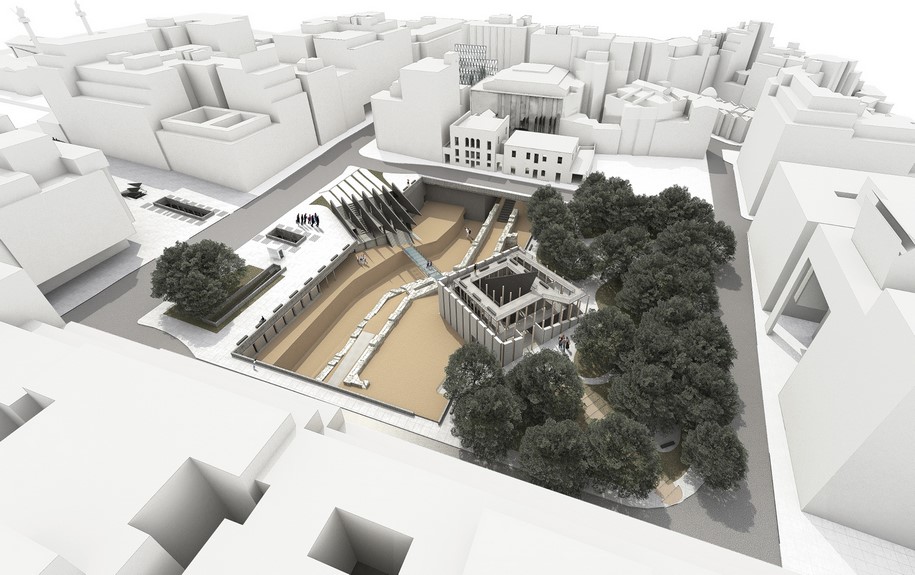
Facts
Project title Reclaiming Ancient traces˙ the Ancient Circuit Wall of Athens
Student Ioannis Giannakopoulos-Tselikas
Course Diploma Design Thesis
Date March 2017
Supervisor Georgios A. Panetsos
University Patras School of Architecture
Credits Anna Maria Theocharaki and her archaeological research (“The Ancient Circuit Wall of Athens: Its Changing Course and the Phases of Construction” & Hesperia: The Journal of the American School of Classical Studies at Athens) | Ephorate of Antiquities of Athens for his helpful advises and material
–
Στόχος της διπλωματικής εργασίας “Ανάκτηση, Ανάδειξη, Αναβάθμιση: η περίπτωση του αρχαίου οχυρωματικού περιβόλου της Αθήνας” του Γιάννη Γιαννακόπουλου-Τσελίκα είναι η ανάκτηση και ανάδειξη μεγάλου όγκου των αποκαλυφθέντων τμημάτων του αρχαίου οχυρωματικού περιβόλου της Αθήνας, γνωστού και ως Θεμιστόκλειου περιβόλου, που παραμένει αφανής κάτω από τη σύγχρονη ανάπτυξη της πόλης και του αστικού της εδάφους.
-κείμενο του δημιουργού
Περιπλανώμενος στη σύγχρονη Αθήνα, δύσκολα μπορεί κανείς να αντιληφθεί και να διακρίνει τα «όρια» μεταξύ του αρχαίου και του νέου. Στη συμπλοκή του εμφανούς και αφανούς ιστορικού φυσικού τοπίου με αυτό του θεσμικού-δομημένου, έχει επέλθει μια δυσδιάκριτη σχέση ανάμεσα τους. Ένα βασικό στοιχείο διάκρισης και οριοθέτησης που λείπει από τη σύγχρονη πραγματικότητα της Αθήνας και επιζητά την Ανάκτηση του είναι ο αρχαίος οχυρωματικός περίβολος της Αθήνας, γνωστός και ως Θεμιστόκλειος περίβολος.
Σκοπός της παρούσας μελέτης είναι η Ανάκτηση και Ανάδειξη μεγάλου όγκου των αποκαλυφθέντων τμημάτων του τείχους το οποίο παραμένει αφανές, κάτω από τη σύγχρονη ανάπτυξη της πόλης και του αστικού της εδάφους, σε μικρό ή μεγάλο βάθος, ανάμεσα σε θεμέλια και υποδομές. Με αυτόν τον τρόπο καθίσταται δυνατή η επικείμενη Αναβάθμιση όχι μόνον του μνημείου, αλλά και της πόλης η οποία αναμένεται να παίξει τον ρόλο της «αστικής βιτρίνας» του.
Η στρατηγική ανάδειξης του αρχαίου τείχους που ακολουθείται εξυπηρετεί την ενιαία ανάδειξη ενός μεγάλου τμήματός του, όπου τα αρχαιολογικά κατάλοιπα και οι πληροφορίες που αντλούνται σε σχέση με τις θέσεις, τη μορφή και την έδρασή του δημιουργούν πρόσφορο έδαφος για τη σύλληψη της. Επιπλέον, το τμήμα του τείχους που επιλέχθηκε βρίσκεται σε κεντρικό σημείο της Αθήνας και συγκεκριμένα βορειοανατολικά εντός του ιστορικού τριγώνου, με αποτέλεσμα την αλληλοεπικάλυψη του με ενδιαφέροντα δημόσια και ιδιωτικά κτήρια, και ανοιχτούς χώρους.
Η ενιαία αυτή ανάδειξη τμήματος του μνημείου του αρχαίου οχυρωματικού περιβόλου της Αθήνας είναι μια αστική επέμβαση, η οποία περιλαμβάνει τον αρχαιολογικό περίπατο πάνω στην αρχαία στάθμη της κιμηλιάς[1], και τον αστικό περίπατο στο δομημένο και μη περιβάλλον της σύγχρονης πόλης πάνω στο οποίο το ιστορικό μνημείο αποκαλύπτεται και αναδεικνύεται.
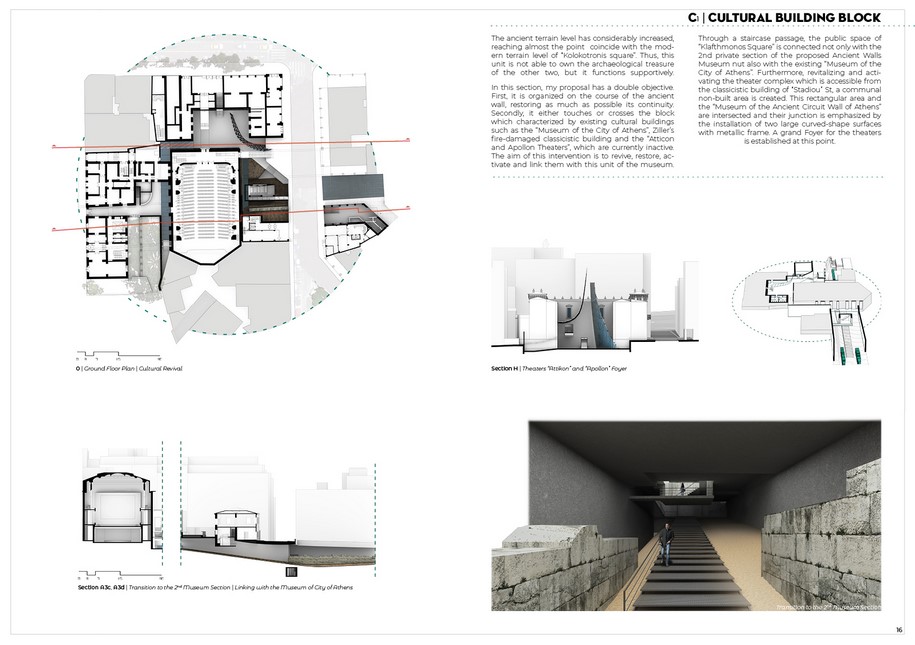
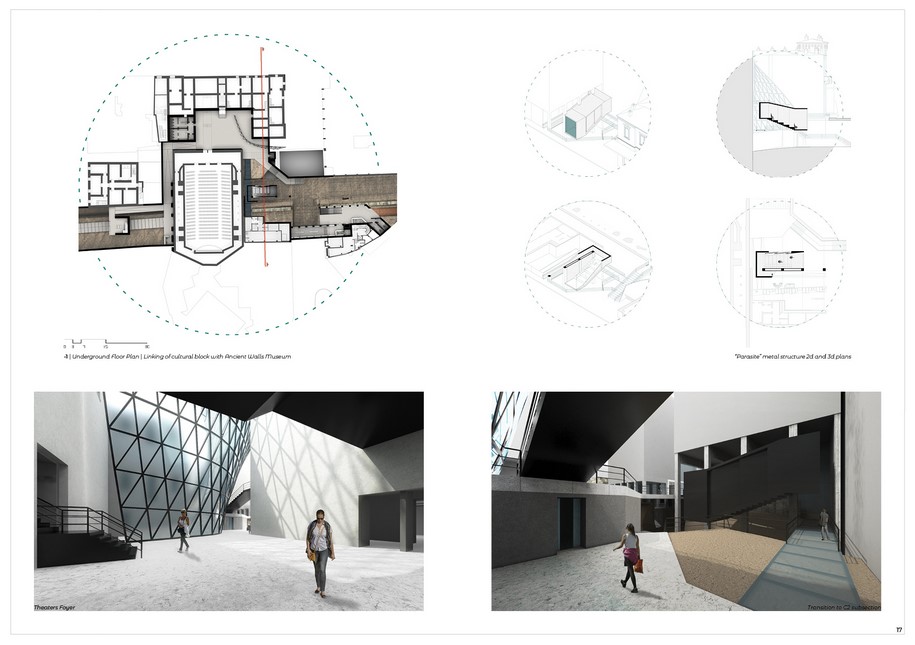
Η επέμβαση αυτή ξεκινά και ολοκληρώνεται από το Γρυπάρειο Μέγαρο μέχρι και τη πλατεία Κολοκοτρώνη ή και αντίστροφα. Στο ενδιάμεσο, η επέμβαση περιλαμβάνει την πλατεία Κλαυθμώνος και τα δυο οικοδομικά τετράγωνα εκατέρωθεν της. Πλαισιώνεται μέσω της δημιουργίας ενός μουσείου για τα αρχαία τείχη της Αθήνας διακοπτόμενο από την πλατεία όπου ο αρχαιολογικός της χώρος και οι επεμβάσεις που παρουσιάζονται, διατήρησαν τον δημόσιο χαρακτήρα της.
Η ανάδειξη του οχυρωματικού περιβόλου της Αθήνας διακρίνεται σε τρεις βασικές ενότητες (A, B, C). Συνολικά οργανώνεται σε μια διαδρομή παράλληλα στα αρχαία κατάλοιπα, στη θέση της αρχαίας εξωτερικής περιφερειακής οδού.
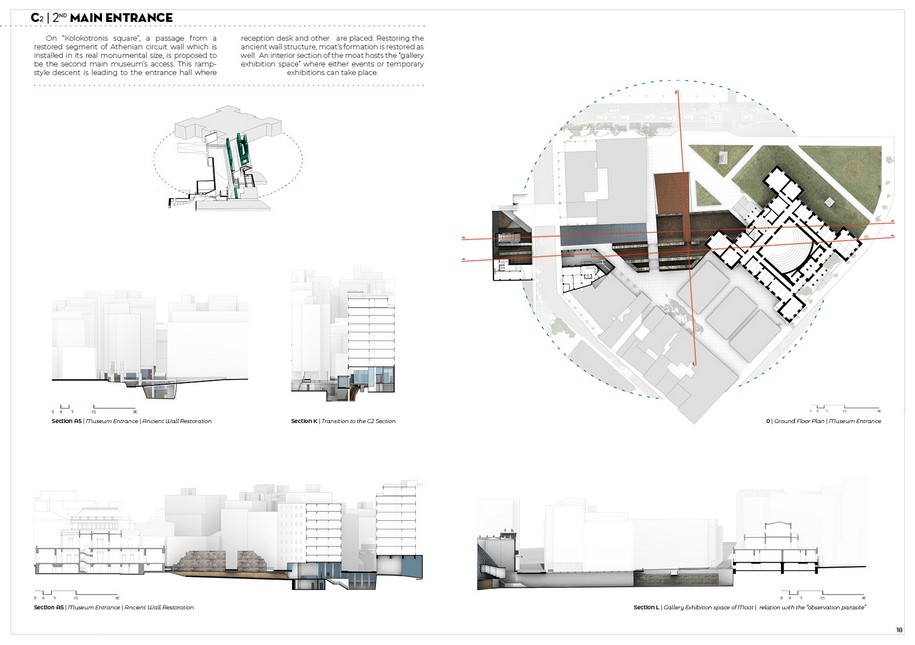
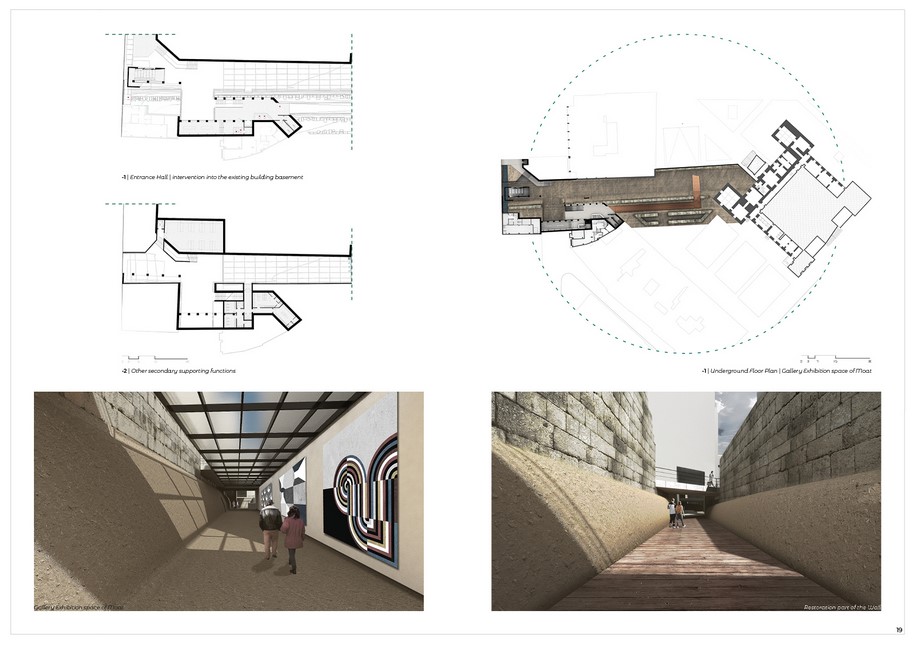
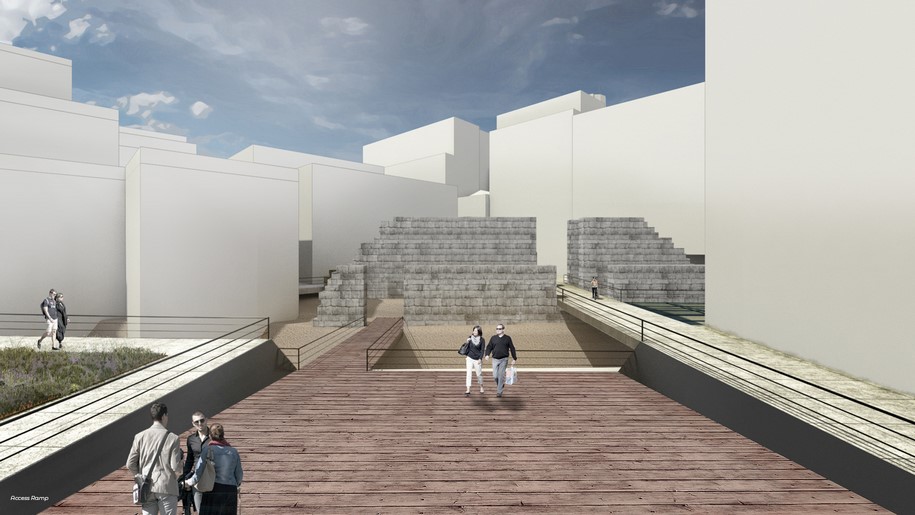
Η ανάδειξη του περιβόλου, παράλληλα με αυτή των υλικών καταλοίπων του, είναι σε θέση να συμβάλλει σε μείζονα βαθμό σε εγχειρήματα οριοθέτησης αλλά και ανάδειξης του ιστορικού πυρήνα της πόλης. Σαν αποτέλεσμα, ενδυναμώνεται η ουσιαστική σχέση του πολίτη με την ιστορία της πόλης του.
Ταυτόχρονα η ανάδειξη του μεγάλου αυτού τμήματος του περιβόλου ενισχύει και ενισχύεται από αστικά αθηναϊκά στοιχεία της σύγχρονης πραγματικότητας που είτε είναι παραμελημένα και υποβαθμισμένα είτε ανενεργά και κατεστραμμένα. Τέτοια στοιχεία είναι ακάλυπτοι χώροι οικοδομικών τετραγώνων, αθηναϊκές εμπορικές στοές, πολιτιστικοί χώροι όπως μουσεία και θέατρα, ανοιχτοί δημόσιοι χώροι, όπως πλατείες, και υπολειμματικοί χώροι του δομημένου περιβάλλοντος. Η γραμμική αυτή ενιαία επέμβασης ενοποιεί όλες αυτές τις διαφορετικές πτυχές της πόλης.
Η πόλη αναβαθμίζεται.
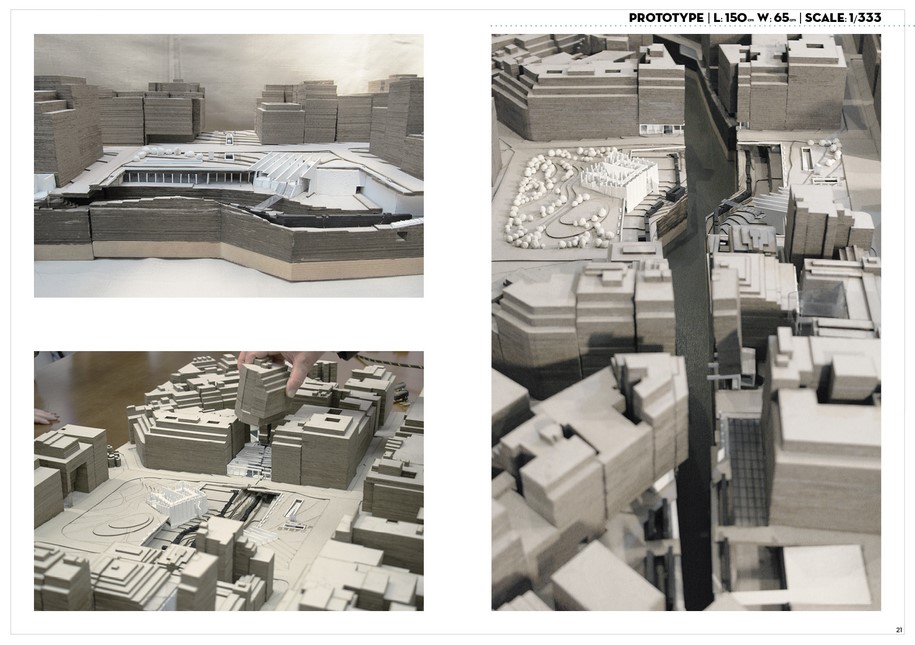
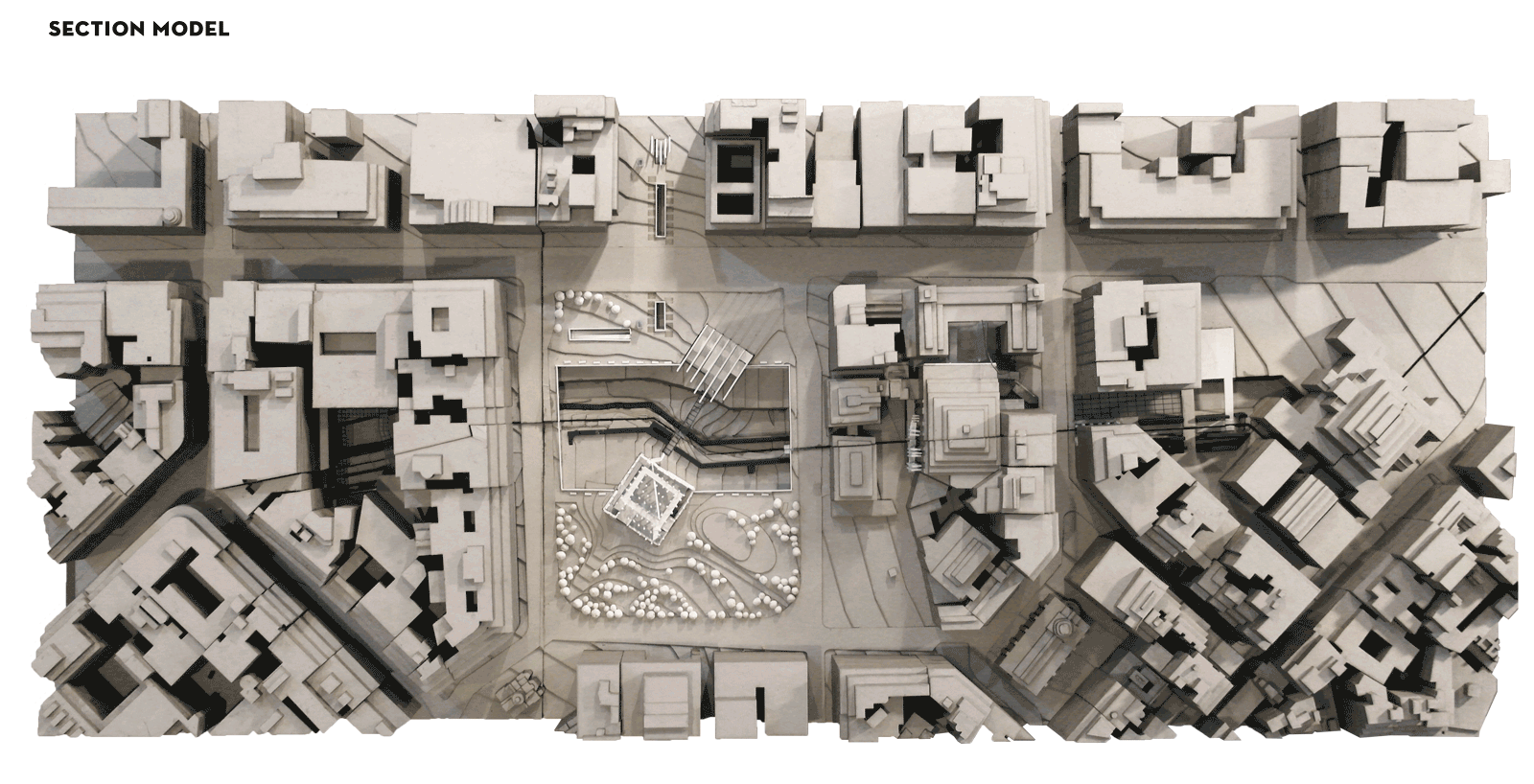
Στοιχεία έργου
Τίτλος Ανάκτηση, Ανάδειξη, Αναβάθμιση: η περίπτωση του αρχαίου οχυρωματικού περιβόλου της Αθήνας
Φοιτητής Ιωάννης Γιαννακόπουλος-Τσελίκας
Ημερομηνία Μάρτιος 2017
Μάθημα Διπλωματική εργασία
Επιβλέπων Γεώργιος Α. Πανέτσος
Πανεπιστήμιο Πανεπιστήμιο Πατρών, Τμήμα Αρχιτεκτόνων Μηχανικών
Ευχαριστίες Άννα Μαρία Θεοχαράκη (διδάκτορος Πανεπιστημίου Aθηνών, με μεταπτυχιακό δίπλωμα Master of Arts in International History από το LSE – London School of Economics) και στο βιβλίο της «Tα Aρχαία Tείχη των Aθηνών») |
Εφορεία Αρχαιοτήτων Αθηνών για τις χρήσιμες συμβουλές και υλικό που μου παρείχε
[1] αρχαίος βράχος πάνω στον οποίο εδραζόταν το τείχος
browse through student projects on Archisearch here!
–
δείτε περισσότερες εργασίες φοιτητών εδώ!
READ ALSO: ΑΝΑΣΤΕΛΛΟΝΤΑΣ ΤΗ ΒΙΟΜΗΧΑΝΙΚΗ ΕΡΕΙΠΩΣΗ_ Μια πρόταση επανένταξης στον Πύργο Ηλείας | Μαρία Μιχαλοπούλου